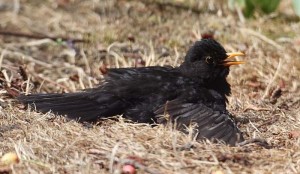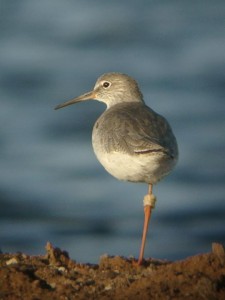Winter Warmers
It doesn’t seem to matter how cold and severe the weather is, our garden birds are still out in force, feeding away and going about their business as usual, all whilst we hide away watching from the safety of our warm houses. Here at the Visitor Centre Tree Sparrows, Goldfinch, Chaffinch and Blue Tits can be seen can still be seen throughout the winter in large numbers. Even though it hasn’t been the coldest of winters it’s still hard to stop yourself asking, how do they cope?
Like us, birds are warm blooded animals, and actually maintain a higher average body temperature than ourselves (40°C compared to our 37°C). Being much smaller than us, however, presents challenges when it comes to maintaining this body heat. With proportionally large surface areas in which to lose heat to the surroundings coupled with much smaller cores to generate this heat have led to birds evolving various different methods to keep themselves warm.
The adaptations can be split into two main groups, physical and behavioural. The main physical adaptation is of course their feathers, which provide excellent insulation against the cold. A lot of bird species, will grow extra feathers as part of their winter plumage, therefore adding an extra layer of insulation when it’s most needed. Many bird species, mostly aquatic ones, also have oil that coats their feathers, providing both waterproofing and insulation properties. The most vulnerable area of the body for heat loss in birds is the extremities, so they have developed physical adaptations to overcome this also. Their legs and feet are covered with special scales that help to minimise heat loss along with using a counter-current heat system in their legs and feet. This system works by passing warmth from blood in the veins running towards the feet to the blood flowing away from feet and back towards the body. This therefore reduces the heat of the legs and feet, instead keeping in the body core and reducing the amount of heat that can be lost to the external environment. Birds can also increase their fat reserves over winter by gorging on food in the Autumn before its availability reduces and the harsher conditions arrive. These fat reserves provide extra insulation as well as providing a source of additionally energy that they can use at any point to help generate body heat.

The majority of behavioural adaptations once again involve the use of their feathers, an essential tool against the cold. Birds can fluff up their feathers and therefore create extra pockets of insulation along with using them to tuck any body parts that are susceptible to heat loss, away from the cold. This also provides the answer to the age old question, why on earth is that bird standing on one leg!? By doing so, it’s reducing the body parts in contact with the cold water or ground and therefore reducing heat loss. The use of their feathers is also essential when ‘sunning’ themselves, a behaviour used on sunny winter days allowing them to heat their feathers and skin more effectively. Here at the Centre, this behaviour often turns heads, as Blackbirds in particular, who are drooping their wings, spreading their tails and raising their feathers look far from normal! An additional way in which birds can generate extra heat, and a method that humans also use, is shivering. Although an energy consuming way to generate heat, shivering is one of the most effective short term solutions to overcoming the cold. A final behaviour that birds use to overcome the cold, particularly smaller passerines but also many wader and waterfowl species, is roosting. Birds of the same species will gather in flocks of various sizes at night, crowding together in small spaces to help share and conserve body heat.

So the next time you peer out of the window and see the bird feeding around your bird table just give a thought to the many methods they need to employ to simply stay warm!
Craig Shepherd,
Visitor Centre Assistant Manager.
Help protect Scotland’s wildlife
Our work to save Scotland’s wildlife is made possible thanks to the generosity of our members and supporters.
Join today from just £3 a month to help protect the species you love.
Preface
It doesn’t seem to matter how cold and severe the weather is, our garden birds are still out in force, feeding away and going about their business as usual, all …
